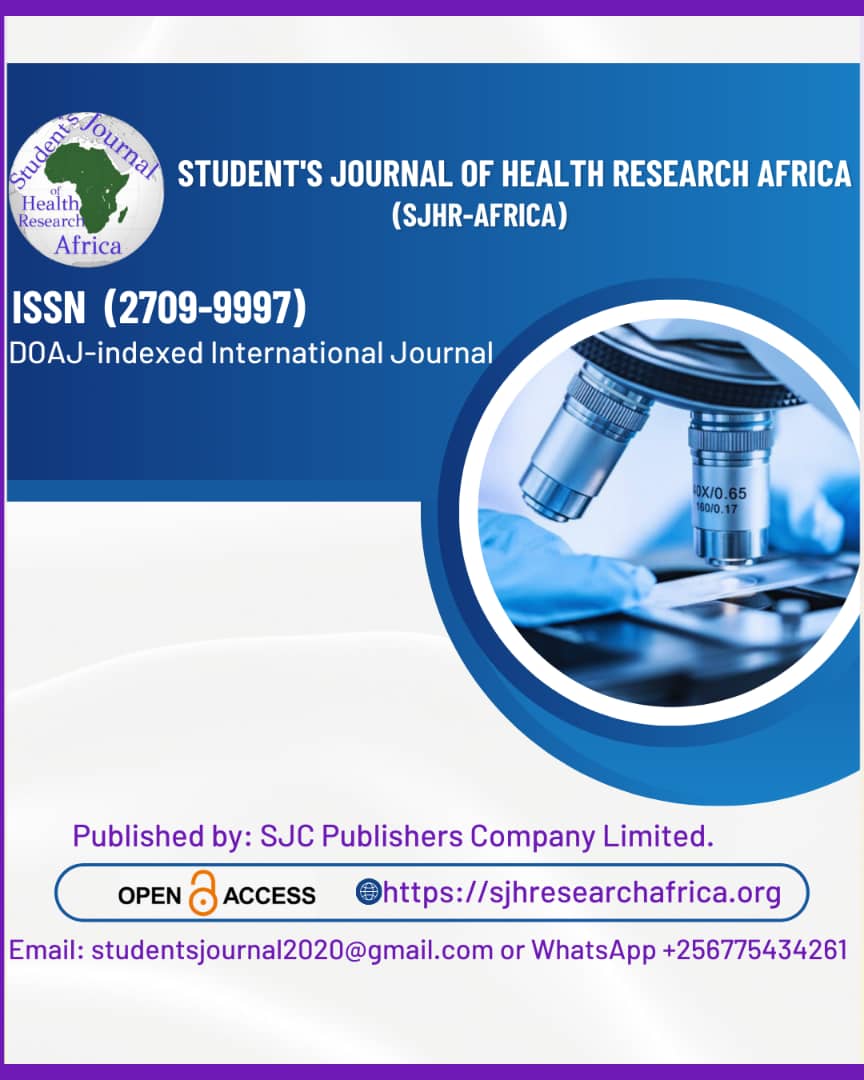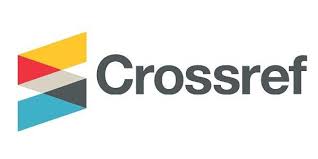Systematic review of the therapeutic potential of the hiccup-nut tree, Combretum bracteosum (Hochst.) Brandis.
DOI:
https://doi.org/10.51168/sjhrafrica.v6i9.2083Keywords:
Bush willow family, Combretaceae, Combretum bracteosum, materia medica, traditional medicineAbstract
Background
Combretum bracteosum (Hochst.) Brandis is a free-standing and many-stemmed shrub or a small tree used in traditional medicine throughout its distributional range. The current study aimed at reviewing the medicinal uses and ethnopharmacological properties of C. bracteosum.
Methods
A systematic review of scientific literature on the therapeutic potential of C. bracteosum was conducted following the Preferred Reporting Items for systematic reviews and meta-analyses (PRISMA). The literature search was conducted using databases PubMed, Web of Science, ScienceDirect, Google Scholar, SpringerLink, Scopus, and SciELO, as well as pre-electronic literature sources such as book chapters, books, and other scientific publications obtained from the university library.
Results
Results from this systematic review revealed that C. bracteosum is used as traditional medicine against backache, convulsions, earache, epilepsy, fever, headache, hiccough, menstrual pains, rheumatism, toothache, and scalp infection in children. The phytochemical assessment of C. bracteosum showed that the species contains proanthocyanidin, gallotannin, anthocyanin, flavonol, flavonoids, phenolics, saponins, steroids, cardiac glycosides, and tannins. The crude extracts of C. bracteosum demonstrated antibacterial, antimycobacterial, antifungal, anti-inflammatory, antioxidant, and GABAA-benzodiazepine receptor binding activities.
Conclusion
This traditional ecological knowledge about C. bracteosum accumulated from the past to the present is extremely important and of great value in the assessment of the therapeutic potential and ethnopharmacological value of the species.
Recommendations
Future research on C. bracteosum should focus on detailed phytochemical, pharmacological, and toxicological evaluations of the crude extracts as well as phytochemical compounds isolated from the species.
References
Ahmed, A.S., McGaw, L.J., Elgorashi, E.E., Naidoo, V., and Eloff, J.N. (2014). Polarity of extracts and fractions of four Combretum (Combretaceae) species used to treat infections and gastrointestinal disorders in southern African traditional medicine has a major effect on different relevant in vitro activities. Journal of Ethnopharmacology,154, 339–350. http://dx.doi.org/10.1016/j.jep.2014.03.030
Ajao, A.A.-N., Mukaila, Y.O. and, Sabiu, S. (2022). Wandering through southwestern Nigeria: An inventory of Yoruba useful angiosperm plants. Heliyon, 8, e08668. https://doi.org/10.1016/j.heliyon.2021.e08668
Anokwuru, C.P., Sandasi, M., Chen, W., Van Vuuren, S., Elisha, I.L., Combrinck, S. and, Viljoen, A.M. (2021). Investigating antimicrobial compounds in South African Combretaceae species using a biochemometric approach. Journal of Ethnopharmacology, 269, 113681. https://doi.org/10.1016/j.jep.2020.113681
Anokwuru, C.P., Chen, W., Van Vuuren, S., Combrinck, S. and, Viljoen, A.M. (2022). Bioautography-guided HPTLC–MS as a rapid hyphenated technique for the identification of antimicrobial compounds from selected South African Combretaceae species. Phytochemical Analysis, 33(8):1177‐1189. https://doi.org/10.1002/pca.3167
Arnold, T.H., Prentice, C.A., Hawker, L.C., Snyman, E.E., Tomalin, M., Crouch, N.R., and Pottas-Bircher, C. (2002). Medicinal and magical plants of southern Africa: An annotated checklist. National Botanical Institute, Strelitzia 13, Pretoria.
Aubrey, A. (2004). Combretum bracteosum (Hochst.) Brandis. Walter Sisulu National Botanical Garden. Available from: https://pza.sanbi.org/combretum-bracteosum, accessed on 12 April 2025
Aworinde, D.O. and Erinoso, S.M. (2015). Ethnobotanical investigation of indigenous plants used in the management of some infant illnesses in Ibadan, southwestern Nigeria. African Journal of Traditional Complementary and Alternative Medicine, 12(1), 9–16. http://dx.doi.org/10.4314/ajtcam.v12i1.2
Bennett, B.C. and Balick, M.J. (2014). Does the name really matter? The importance of botanical nomenclature and plant taxonomy in biomedical research. Journal of Ethnopharmacology, 152, 387–392. http://dx.doi.org/10.1016/j.jep.2013.11.042
Boon, R.G.C., Jordaan, M. and, Van Wyk, A.E. (2020). A new species of Combretum sect. Ciliatipetala (Combretaceae) from South Africa. Phytotaxa, 434(1), 1-12. https://doi.org/10.11646/phytotaxa.434.1.1
Bredenkamp, C.L. (2019). A flora of the Eastern Cape province, volume 1. Strelitzia 41, South African National Biodiversity Institute, Pretoria
Bussmann, R.W. (2022). Taxonomy: An irreplaceable tool for validation of herbal medicine revisited. In: Mukherjee, P.K. (Editor.), Evidence-based validation of herbal medicine. Elsevier, Amsterdam, pp. 149–183
Dalling, K.J. and, Van Staden, J. (1999). Germination requirements of Combretum bracteosum seeds. South African Journal of Botany, 65, 83-85. https://doi.org/10.1016/S0254-6299(15)30943-1
Ejidike, I.P., Mtunzi, F.M., Ledwaba, I., Phele, M.J., Ejidike, O.M., Ogunleye, O., Ata, A., and Eze, M.O. (2023). Combretum species around Africa as alternative medicine: Ethnopharmacological and ethnobotanical importance. Journal of Applied Pharmaceutical Science,13(8), 12-29. https://doi.org/10.7324/JAPS.2023.20644
Ekeke, C., Agbagwa, I.O. and, Okoli, B.E. (2013). Mitotic studies on Combretum Loefl. from Nigeria. American Journal of Plant Sciences, 4, 508-511. http://dx.doi.org/10.4236/ajps.2013.43064
Eloff, J.N. (1999). The antibacterial activity of 27 Southern African members of the Combretaceae. South African Journal of Science, 95, 148–152
Eloff, J.N., Jäger, A.K., and Van Staden, J. (2001). The stability and relationship between anti-inflammatory activity and antibacterial properties of southern African Combretum species. South African Journal of Science 97, 291–293.
Erinoso, S.M. and Aworinde, D.O. (2012). Ethnobotanical survey of some medicinal plants used in traditional health care in Abeokuta areas of Ogun State, Nigeria. African Journal of Pharmacy and Pharmacology, 6(18), 1352–1362. http://dx.doi.org/10.5897/AJPP12.127
Geng, Y., Ranjitkar, S., Yan, Q., He, Z., Su, B., Gao, S., Niu, J., Bu, D., and Xu, J. (2020). Nutrient value of wild fodder species and the implications for improving the diet of mithun (Bos frontalis) in Dulongjiang area, Yunnan province, China. Plant Diversity, 2020, 42(6), 455-63. https://doi.org/10.1016/j.pld.2020.09.007
Gere, J., Yessoufou, K., Daru, B.H., Maurin, O., and Van Der Bank, M. (2015). The African continent is a likely origin of the family Combretaceae (Myrtales). A biogeographical view. Annual Research and Review in Biology, 8, 1–20. https://doi.org/10.9734/ARRB/2015/17476
Germishuizen, G. and, Meyer, N.L. (2003). Plants of southern Africa: An annotated checklist. Strelitzia 14, National Botanical Institute, Pretoria
Gordon, D.R. and Gantz, C.A. (2008). Potential impacts on the horticultural industry of screening new plants for invasiveness. Conservation Letters, 1, 227-235
Grimsey, L., Van Vuuren, S.F., Wright, M.H., and Cock, I.E. (2024). Selected South African Combretum spp. Extracts inhibit methicillin-resistant Staphylococcus aureus and ESBL strains of Escherichia coli and Klebsiella pneumoniae. South African Journal of Botany, 165, 49-58. https://doi.org/10.1016/j.sajb.2023.12.018
Henning, G.A. and Henning, S.F. (1997). Living butterflies of southern Africa. Umdaus Press, Pretoria.
Jäger, A. and, Van Staden, J. (2005). Cyclooxygenase inhibitory activity of South African plants used against inflammation. Phytochemistry Reviews, 4, 39–46. https://doi.org/10.1007/s11101-004-5570-7
Joffe, P. (2001). Creative gardening with indigenous plants: A South African guide. Briza Publications, Pretoria.
Johnson, D. and Johnson, S. (1993). Gardening with indigenous trees and shrubs. Southern Books, Halfway House, Johannesburg.
Jordaan, M., Van Wyk, A.E. and, Maurin, O. (2011). A conspectus of Combretum (Combretaceae) in southern Africa, with taxonomic and nomenclatural notes on species and sections. Bothalia, 41(1), 135–160. https://doi.org/10.4102/abc.v41i1.36
Koen, K.J. (2001). Cultivation of Combretum bracteosum (Hochst.) Brandis. PhD Thesis, University of Natal, Pietermaritzburg
Kok, A.-M., Meyer, D., and Lall, N. (2025). Adjuvant properties of selected medicinal plants for tuberculosis treatment. South African Journal of Botany, 177, 555-560. https://doi.org/10.1016/j.sajb.2024.12.028
Manning, J., Batten, A., and Bokelmann, H. (2001). Eastern Cape South African wild flower guide 11. The Botanical Society of South Africa, Cape Town.
Maroyi, A. (2006). A preliminary checklist of naturalized and introduced plants in Zimbabwe. Kirkia, 18, 177-247
Maroyi, A. (2025). The leadwood tree (Combretum imberbe Wawra, family Combretaceae): Medicinal uses and ethnopharmacological properties. Ethnobotany Research and Applications, 30, 50. http://dx.doi.org/10.32859/era.30.50.1-14
Masoko, P., Picard, J., and Eloff, J.N. (2007). The antifungal activity of twenty-four southern African Combretum species (Combretaceae). South African Journal of Botany, 73, 173–183. https://doi.org/10.1016/j.sajb.2006.09.010
Mathipa, M.M., Mphosi, M.S., and Masoko, P. (2022). Phytochemical profile, antioxidant potential, proximate and trace elements composition of leaves, stems, and ashes from 12 Combretum spp. Used as food additives. International Journal of Plant Biology, 13, 561–578. https://doi.org/ 10.3390/ijpb13040045
Maurin, O., Chase, M.W., Jordaan, M. and, Van Der Bank, M. (2010). Phylogenetic relationships of Combretaceae inferred from nuclear and plastid DNA sequence data: Implications for generic classification. Botanical Journal of the Linnean Society, 162, 453-476. https://doi.org/10.1111/j.1095-8339.2010.01027.x
McGaw, L.J., Rabe, T., Sparg, S.G., Jäger, A.K., Eloff, J.N., and Van Staden, J. (2001). An investigation into the biological activity of Combretum species. Journal of Ethnopharmacology, 75, 45–50. https://doi.org/10.1016/S0378-8741(00)00405-0
Nair, R.N. (2017). Green corrosion inhibitors for mild steel in acidic medium. International Journal of Modern Trends in Engineering and Research, 4(12), 2016-2021. https://doi.org/10.21884/IJMTER.2017.4405.OQRS0
Nwigwe, U.S., and Nwoye, C.I. (2023). The efficacy of plant inhibitors as used against structural mild steel corrosion: A review. Portugaliae Electrochimica Acta, 40, 381-395. https://doi.org/10.4152/pea.2023410505
Ogunleye, O.O., Arinkoola, A.O., Alagbe, S.O., Agbede, O.O., Omodele, A.E., Morakinyo, A.F., and Osho, Y.A. (2020). Synthesis of green corrosion inhibitor for mild steel in an acidic environment. Indian Chemical Engineer, 62(1), 52-66. https://doi.org/10.1080/00194506.2019.1625815
Okafor, P.C., Uwah, I.E., Ekerenam, O.O. and, Ekpe, U.J. (2009). Combretum bracteosum extracts as an eco-friendly corrosion inhibitor for mild steel in acidic medium. Pigment and Resin Technology, 38(4), 236–241. http://dx.doi.org/10.1108/03699420910973323
Olukoya, D.K., Idika, N., and Odugbemi, T. (1993). Antibacterial activity of some medicinal plants from Nigeria. Journal of Ethnopharmacology, 39, 69–72. https://doi.org/10.1016/0378-8741(93)90051-6
Page, M. J., McKenzie, J. E., Bossuyt, P. M., Boutron, I., Hoffmann, T., Mulrow, C., Shamseer, L., Tetzlaff, J.M., Akl, E.A., Brennan, S.E., Chou, R., Glanville, J., Grimshaw, J.M., Hróbjartsson, A., Lalu, M. M., Li, T., Loder, E. W., Mayo-Wilson, E., McDonald, S., McGuinness, L.A., Stewart, L.A., Thomas, J., Tricco, A.C., Welch, V.A., Whiting. P. and Moher, D. (2021). The PRISMA 2020 statement: An updated guideline for reporting systematic reviews. British Medical Journal, 372, 71. https://doi.org/10.1136/bmj.n71
Palgrave, C.K. (2002). Coates Palgrave trees of southern Africa. C Struik Publishers, Cape Town
Palmer, E. and Pitman, N. (1972). Trees of southern Africa: Covering all known indigenous species in the Republic of South Africa, South-West Africa, Botswana, Lesotho, and Swaziland. Balkema, Cape Town.
Patni, N., Agarwal, S., and Shah, P. (2013). Greener approach towards corrosion inhibition. Chinese Journal of Engineering, Volume 2013, Article ID 784186. http://dx.doi.org/10.1155/2013/784186
Pearce, J.M.S. (2003). A note on hiccups. Journal of Neurology, Neurosurgery and Psychiatry, 74, 1070. https://doi.org/10.1136/jnnp.74.8.1070
Pooley, E. (1993). The complete field guide to trees of Natal, Zululand and Transkei. Natal Flora Publications Trust, Durban.
Rivera, D., Allkin, R., Obón, C., Alcaraz, F., Verpoorte, R. y Heinrich, M. (2014). What is in a name? The need for accurate scientific nomenclature for plants. Journal of Ethnopharmacology, 152, 393–402. http://dx.doi.org/10.1016/j.jep.2013.12.022
Risa, J., Risa, A., Adersen, A., Gauguin, B., Stafford, G.I., Van Staden, J. and Jäger, A.K. (2004). Screening of plants used in South Africa for epilepsy and convulsions in the GABAA-benzodiazepine receptor assay. Journal of Ethnopharmacology, 93, 177–182. http://dx.doi.org/10.1016/j.jep.2004.01.021
Schmidt, E., Lotter, M., and McCleland, W. (2017). Trees and shrubs of Mpumalanga and Kruger National Park. Jacana Media, Johannesburg.
Singh, A., Ebenso, E.E., and Quraishi, M.A. (2012). Corrosion inhibition of carbon steel in HCl solution by some plant extracts. International Journal of Corrosion, Volume 2012, Article ID 897430. http://dx.doi.org/10.1155/2012/897430
Smith, C.A. (1966). Common names of South African plants. Memoirs of the Botanical Survey of South Africa No. 35. Botanical Research Institute, Pretoria.
Soejarto, D.D., Addo, E.M., and Kinghorn, A.D. (2026). The continuing need for taxonomic input in phytochemical research. Journal of Ethnopharmacology, 354, 120474. https://doi.org/10.1016/j.jep.2025.120474
Stace, C.A. (1980). The significance of the leaf epidermis in the taxonomy of the Combretaceae: Conclusions. Botanical Journal of the Linnean Society, 81, 327-339. https://doi.org/10.1111/j.1095-8339.1980.tb01682.x
Stace, C.A. (2002). Proposal to conserve Terminalia nom. cons. (Combretaceae) against an additional name, Bucida. Taxon, 51, 193-194. https://doi.org/10.2307/1554985
Stace, C.A. (2007). Combretaceae. In: Kubitzki, K. (editor). The Families and Genera of Vascular Plants Volume 9. Springer, Berlin, pp. 67–82. https://doi.org/10.1007/978-3-540-32219-1_11
Uddin, S.N. and, Hassan, M.A. (2018). Vascular flora of Chittagong and the Chittagong Hill Tracts, volume 2. Bangladesh National Herbarium, Dhaka
Uddin, M.S., Mazumder, A. and, Uddin, S.B. (2023). Addition of one hundred and forty-seven new vascular taxa to the flora of Bangladesh. Species, 24, e13s1013. https://doi.org/10.54905/disssi/v24i73/e13s1013
Venter, F. and Venter, J.-A. (2015). Making the most of indigenous trees. Briza Publications, Pretoria
Watt, J.M. and Breyer-Brandwijk, M.G. (1962). The medicinal and poisonous plants of southern and eastern Africa: being an account of their medicinal and other uses, chemical composition, pharmacological effects, and toxicology in man and animal. E & S. Livingstone Ltd., Edinburgh.
Wickens, G.E. (1973). Combretaceae. In: Polhill, R.M. (editors). Flora of tropical East Africa: Combretaceae. Royal Botanic Gardens, Kew, London, pp. 1-209
Wilcox, M., Bradshaw, C., and Cameron, E. (2004). Woody plants of the Auckland Domain. Auckland Botanical Society Journal, 59, 44–56
Downloads
Published
How to Cite
Issue
Section
License
Copyright (c) 2025 Alfred Maroyi

This work is licensed under a Creative Commons Attribution-NonCommercial-NoDerivatives 4.0 International License.





















